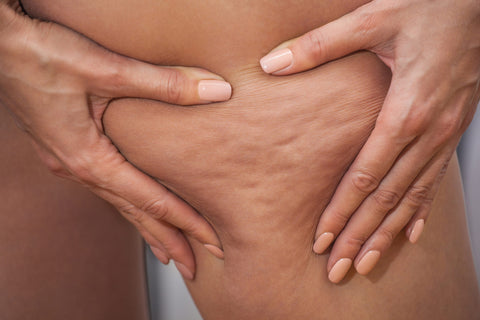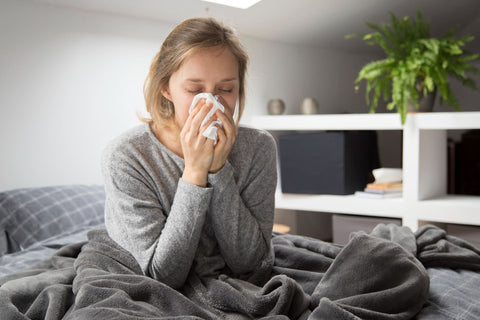What Is Cellulite?
First of all, cellulite shouldn’t be confused with cellulitis, which is a skin infection caused by Staphylococcus aureus or Streptococcus bacteria and leads to inflammation, pain, and swelling in the place the skin was infected through the cut. Cellulitis is usually treated with antibiotics.
Cellulite, on the other hand, is a dimpled (lumped) or loose saggy skin that usually appears on the hips, thighs, buttocks, and belly. Due to the structure of their collagen fibres around 90% of women and only 10% of men suffer from cellulite. It takes place particularly as women age because over time the skin loses its elasticity especially when it is combined with poor blood circulation and weak muscles (lack of exercise), nutritional deficiencies (poor dietary habits) and hormonal imbalances.
Cause Of Cellulite
According to the renowned dermatologist Cheryl Karcher, MD the key cause of cellulite are the structural changes in the collagen fibres (weakness of the connective tissue) caused by hormonal imbalances, lack of exercise (poor muscle tone), sluggish blood circulation and excess fat.
When collagen fibres beneath the skin lose their strength and elasticity, underlying fat cells start to push through the layers of fibres creating lumps of cellulite under the skin.
Under normal circumstances, all fat cells under the skin create regular and even layers because they are nicely attached to connective tissue (collagen fibres) between skin and muscles. But in cellulite part of those fat cells under skin become detached from weakened connective tissue (collagen) stick together and create small lumpy fatty deposits that look just like cottage cheese. As this free-floating fat accumulates and expands in size, it pushes up against the skin, which gives the lumpy appearance and dimpling effect. Cellulite becomes noticeable when the underlying fat deposits begin to push through layers of weak collagen fibres that form connective tissue under the skin.

Another key cause of cellulite is the weakness of blood vessels. When the walls of blood vessels lose elasticity excess fluids and waste products, instead of being excreted, press towards the fat tissue where they attach to the fat cells, thus causing swelling and cellulite. In addition, poor blood circulation leads to the reduced supply of oxygen and nutrients causing the metabolism to slow down.
Also, inability to control stress and overproduction of damaging free radicals as a result of stress contribute to cellulite. According to a 2000 research published in the Journal of European Academy of Dermatology, cellulite is a result of increased levels of catecholamines caused by high stress and raised levels stress hormone – cortisol. In addition, stress and unhealthy diet also limit body’s ability to produce collagen, which is essential to keep skin looking healthy.
List Of Possible Key Causes
The following factors are believed to be the key causes of cellulite or may contribute to this condition:
- Weak collagen and connective tissue structure of the skin. Stress and unhealthy diet also limit body’s ability to produce collagen, which is essential to keep skin looking healthy
- Sluggish blood circulation caused by lack of exercise, dehydration, and diet high in animal products, saturated fat and sugar
- Abnormal levels of female sex hormones (oestrogen & progesterone) or male hormone (testosterone)
- Excess body fat (diet high in animal foods, fat, sugar, fructose, refined foods, and low in unrefined plant products high in fibre). Although it is common to think that only overweight women develop cellulite the truth is this problem also affects women of every size and shape
- Weak muscles under skin (lack of exercise, deficiency of magnesium and other nutrients)
- Lack of elasticity of blood vessel walls caused by poor dietary habits and deficiency of rutin, bioflavonoids
- Dehydration (drinking insufficient amounts of water between meals and diet low in fresh vegetables and fruits)
- Inability to control stress
- Lack of vitamins and minerals
- Build-up of toxins in the body (particularly in fat cells)
- Diet rich in unhealthy fats (including commercial oils)
- Products containing high glucose/fructose syrup
- Diet high in animal products and refined foods
- Eating large amounts of refined sugars, white rice, white bread and other refined flour products, processed foods
- Overeating
- Regular alcohol consumption
- Sluggish metabolism (lack of exercise, deficiency of B vitamins, Coenzyme Q10 and other nutrients and antioxidants)

Conventional Treatment
Liposuction is becoming more and more popular way to treat cellulite but neither liposuction nor other surgical methods of removing cellulite are regarded as effective methods to deal with this problem. According to plastic surgeon Dr. Jed Horowitz, “Though liposuction removes deep fat just beneath the skin, it may not remove cellulite. The American Academy of Dermatology warns that liposuction may actually worsen the appearance of cellulite by creating more depressions in the skin.”
Lifestyle Recommendations
The only effective way of treating cellulite is addressing the above-mentioned causes, focusing on strengthening the connective tissue (collagen) and muscles found under the skin, a long-term weight loss (burning fat slowly and systematically), slowing down the ageing process of the skin cells, improving blood circulation and strengthening blood vessel walls, detoxification of the body and liver, and improving overall health. This goal can be achieved only by eating a healthy unrefined plant (or mostly plant) foods high in fibre and nutrients, getting enough exercise every day, stress control and using good quality herbs, and nutritional supplements.
The more listed below principles you manage to implement the better results you should notice:
- You must hydrate the body every day because dehydration is one of the main causes of cellulite. Lack of water gives the skin a shriveled and lumpy look. Water also helps with detoxification. Drink at least eight to ten glasses of filtered or even better-distilled water every day (3 glasses 3 times a day between meals, not after meals). First 3 glasses drink just after getting up from bed in the morning 30-60 minutes before breakfast. You can squeeze some fresh lemon juice into your water to improve detoxification and taste.
- Consume more high in water hydrating foods such as fresh raw vegetables and fruits.
- Since there is a clear connection between stress and developing cellulite, try to improve your ability to control stress and calm down the nervous system by regular energetic exercise, meditation (prayer), avoiding stimulants (including caffeine), consuming more unrefined high in nutrients plant foods, and supplements such as B Vitamins, Magnesium, Zinc, Omega 3, Siberian Ginseng, Rhodiola, Turmeric, Tulsi (Holy Basil), Chamomile, etc. According to a 2000 research published in the Journal of European Academy of Dermatology, cellulite is also a result of increased levels of catecholamines caused by high stress and raised cortisol levels. In addition, stress and unhealthy diet also limit body’s ability to produce collagen, which is essential to keep skin looking healthy.
- Remember about energetic exercise every day. According to a 2011, a report published in the Journal of Obesity the most effective type of exercise in eliminating cellulite seems to be the High-Intensity Intermittent Exercise (HIIE) as it seems to be more effective at reducing the abdominal and subcutaneous fat.
- Eat more high-fibre foods such as pitted prunes, vegetables, nuts, seeds etc. as fibre helps boost metabolism, balance hormones, cleanse the colon, and reduce hunger.
- Often consume high-quality protein foods such as spirulina, chlorella, cooked organic soya beans, Tofu (soya curd), maca, ground hemp seed, beans, lentils, chickpeas, and brown rice to aid in cellulite reduction.
- Increase consumption of Potassium-rich foods especially fresh raw vegetable salads with cold-pressed flax oil or Humus (chickpeas and sesame paste).
- Avoid foods containing trans-fats such as margarines and unhealthy commercial oils (corn oil, sunflower oil, soya oil or vegetable oil) which trigger systemic inflammation, contribute to cellulite, insulin resistance, and obesity. For cooking use only raw coconut oil, while for salad dressing cold-pressed flax oil or olive oil.
- Avoid white rice, refined flour products, high glucose / high fructose syrup and sugar as it contributes to cellulite by leading to nutritional deficiencies, inflammation, fluid retention, and storage of body fat.
- If you can manage its hot taste take about 1 teaspoon of Cayenne pepper two times a day with meals as it helps burn fat and increases blood circulation in the skin (poor circulation is one of the causes of cellulite).
Supplements and Herbs
- According to Josh Axe, MD, serrapeptase enzyme can dissolve the tissue (fibrinogen) that bonds cellulite tissue. Serrapeptase is often reported by women to be effective in helping reduce cellulite.
- Apart from serrapeptase also other enzymes such as bromelain, has the ability to dissolve fibrinogen (the tissue that holds these unwanted formations together) and often recommended for those who want to eliminate cellulite. According to the research results published in Biotech Research Journal, “Bromelain exhibits various fibrinolytic, antiedematous, antithrombotic, and anti-inflammatory activities”.
- Kelp contains a compound called fucoxanthin (found in chlorophyll) which helps to burn body fat, thus reducing cellulite.
- Medical research has repeatedly pointed to the fact that hormonal imbalance significantly contributes to cellulite. For this reason, balancing sex hormones (estrogen and progesterone in women and testosterone in men) is absolutely critical in dealing with cellulite. You can do it by practicing rules of a healthy lifestyle, consuming more unrefined plant foods, using herbs and nutritional supplements. One of the most important supplements to achieve this goal is boron (5-10 mg a day) as it is the main precursor for all sex hormones. Due to soil depletion and other factors, our diet is almost completely deprived of this important mineral. Star flower oil, Evening primrose oil, and Maca are also often recommended as very beneficial in helping maintain normal hormonal imbalance. Vitamin B6, Omega-3 fatty acids, and vitamin D are crucial for healthy hormonal balance. In addition, they may help reduce the appearance of cellulite also by stimulating brown fat metabolism, helping activate the production of collagen and reducing inflammation.
- Good quality supplements with collagen are often recommended to reduce the appearance of cellulite by strengthening weak collagen fibres found in the skin. In addition, since weak collagen and connective tissue structure of the skin is regarded as the key cause of cellulite your priority should be to strengthen collagen under your skin by using following supplements:
Vitamin C (2 times a day 1000-2000mg with meals). According to two-time Nobel Prize winner Linus Pauling, vitamin C is the most vital vitamin for healthy collagen formation. Another reason you need vitamin C is the fact that its deficiency is to blame for the weak blood vessel walls (another cause of cellulite). Vitamin C strengthens collagen even better when it is combined with amino acids lysine and proline;
Vitamin E (the most abundant antioxidant found in the skin) is also needed for healthy collagen formation;
A 2010 study published in the Journal of Trace Elements in Medicine and Biology concluded that supplementing with copper increased collagen formation in women. It is recommended to use copper also externally in the form of colloidal liquid copper applying it to the skin to increase collagen production;
Another trace element necessary for healthy collagen production is silica which supports not only the skin but also hair and nails.
External Remedies
- One of the best essential oils for external use is grapefruit essential oil because like pineapple it is also high in bromelain. Grapefruit essential oil can be even more effective when mixed with raw organic coconut oil which nourishes, hydrates, and protects the skin. In order to make the cream mix about 30 drops of grapefruit essential oil with 1 cup of raw organic coconut oil in a glass container (don’t use plastic containers). Rub into cellulite in the morning and before bed.
- Make an apple cider vinegar (must be with mother!) body wrap by mixing it with the same amount of filtered or distilled water. Soak a cotton cloth in the solution, place it on the cellulite area, wrap it with a cling film and a towel and leave for 2 hours.
Sources
- https://draxe.com/how-to-get-rid-of-cellulite/
- https://www.healthline.com/nutrition/cellulite#section3
- Cellulite - Symptoms and causes - Mayo Clinic
- https://wellnessmama.com/8608/natural-cellulite-remedies/
Images: Human skin vector created by brgfx - www.freepik.com
Any information or product suggested on this website is not intended to diagnose, treat, cure or prevent any medical condition. Never disregard medical advice or delay in seeking it because of something you have read on this website. Consult your primary healthcare physician before using any supplements or making any changes to your regime.





